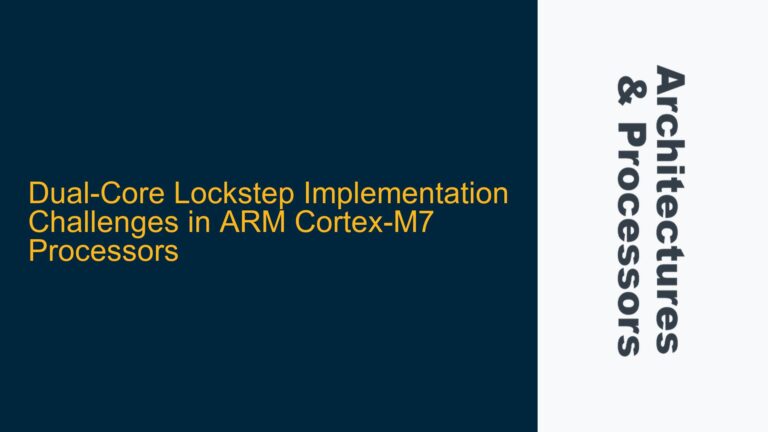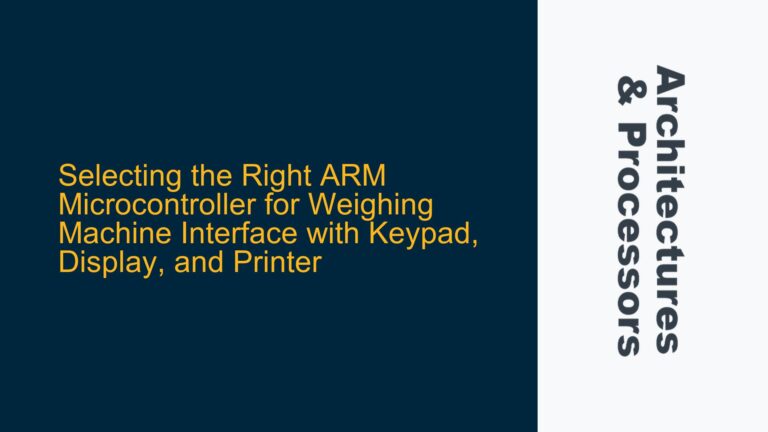ARMv8 FPU and SIMD Execution Units: Scalar Floating-Point Operations in AArch64
The ARMv8 architecture introduces significant advancements in floating-point and SIMD (Single Instruction, Multiple Data) capabilities, particularly with the integration of Advanced SIMD (NEON) and VFP (Vector Floating-Point) technologies. However, the relationship between these units and their roles in executing scalar floating-point operations can be ambiguous, especially when transitioning from ARMv7 to ARMv8. This guide aims to clarify the distinctions between the FPU (Floating-Point Unit) and SIMD execution units in ARMv8, focusing on scalar floating-point operations in AArch64.
Micro-Architectural Implementation of FPU and SIMD in ARMv8
The ARMv8 architecture defines a set of instructions and functional behaviors but does not prescribe a specific micro-architectural implementation. This means that while the architecture specifies what instructions like FADD S0, S1, S2 (a scalar 32-bit floating-point addition) should do, it does not dictate whether these instructions are executed in a dedicated FPU, the Advanced SIMD (NEON) unit, or a shared pipeline. The actual implementation depends on the specific processor design, such as Cortex-A53, Cortex-A57, or other ARMv8-compliant cores.
In ARMv8, the Advanced SIMD (NEON) and VFPv4 (Vector Floating-Point) functionalities are often integrated into a unified execution unit, but this is not a strict requirement. For example, in Cortex-A53, the Advanced SIMD and FPU pipelines are typically combined, allowing scalar floating-point operations to be executed in the same unit as SIMD operations. However, in other designs, such as Cortex-A57, the FPU and SIMD units might be more distinct, with separate pipelines for scalar and vector operations.
The key takeaway is that the execution unit for scalar floating-point operations in ARMv8 is micro-architecture-dependent. While the Advanced SIMD unit is often capable of handling both scalar and vector floating-point operations, the presence of a dedicated FPU (such as VFPv4) can vary between implementations.
Scalar Floating-Point Execution in Advanced SIMD vs. VFP
In ARMv8, scalar floating-point operations like FADD S0, S1, S2 can be executed in either the Advanced SIMD (NEON) unit or a dedicated FPU (VFP), depending on the processor design. The Advanced SIMD unit in ARMv8 is designed to handle both scalar and vector operations, making it a versatile choice for floating-point arithmetic. However, the VFP unit, which was prominent in ARMv7, is still present in some ARMv8 implementations, particularly for backward compatibility and specific use cases.
The Advanced SIMD unit in ARMv8 supports the AArch64 execution state, where it is referred to as "AdvSIMD." This unit is capable of executing scalar floating-point operations using the "S" registers (32-bit single-precision) and "D" registers (64-bit double-precision). For example, the FADD S0, S1, S2 instruction would typically be executed in the Advanced SIMD unit, as it is optimized for both scalar and vector operations.
On the other hand, the VFP unit, which was the primary FPU in ARMv7, is still present in ARMv8 but is often integrated into the Advanced SIMD unit. In some implementations, the VFP unit might handle specific scalar floating-point operations, particularly in AArch32 mode, where legacy VFP instructions are used. However, in AArch64 mode, the Advanced SIMD unit is generally the default execution unit for scalar floating-point operations.
The distinction between Advanced SIMD and VFP becomes less relevant in ARMv8, as the Advanced SIMD unit is designed to handle both scalar and vector operations efficiently. However, understanding the micro-architectural implementation of your specific processor is crucial for optimizing performance and ensuring compatibility.
Optimizing Scalar Floating-Point Performance in ARMv8
To optimize scalar floating-point performance in ARMv8, it is essential to understand the micro-architectural implementation of your processor and the role of the Advanced SIMD and VFP units. Here are some key considerations and steps to ensure optimal performance:
-
Identify the Execution Unit: Determine whether your processor uses a unified Advanced SIMD unit or separate FPU and SIMD units. This information can typically be found in the processor’s technical reference manual. For example, Cortex-A53 uses a unified unit, while Cortex-A57 might have more distinct pipelines.
-
Use AArch64 for Scalar Floating-Point Operations: In AArch64 mode, the Advanced SIMD unit is optimized for both scalar and vector operations. Using AArch64 instructions like
FADD S0, S1, S2ensures that scalar floating-point operations are executed efficiently. -
Leverage SIMD for Vector Operations: If your application involves both scalar and vector floating-point operations, ensure that vector operations are explicitly coded using Advanced SIMD instructions. This allows the processor to take full advantage of the SIMD capabilities, improving overall performance.
-
Minimize Mode Switching: Avoid frequent switching between AArch32 and AArch64 modes, as this can introduce overhead and reduce performance. Stick to AArch64 for applications that require significant floating-point computation.
-
Profile and Optimize: Use profiling tools to identify performance bottlenecks in your floating-point code. Focus on optimizing critical sections, such as loops and mathematical functions, to ensure efficient use of the execution units.
-
Consider Compiler Optimizations: Modern compilers, such as GCC and Clang, offer optimizations for ARMv8 floating-point and SIMD instructions. Ensure that your compiler settings are configured to generate optimized code for your specific processor.
By understanding the micro-architectural implementation of your ARMv8 processor and following these optimization steps, you can ensure efficient execution of scalar floating-point operations and maximize performance in your applications.
In summary, the execution of scalar floating-point operations in ARMv8 depends on the micro-architectural implementation of the processor. While the Advanced SIMD unit is typically the default execution unit for scalar operations in AArch64, the presence of a dedicated FPU (VFP) can vary between designs. By understanding the specific implementation of your processor and following best practices for optimization, you can achieve optimal performance in your floating-point computations.






